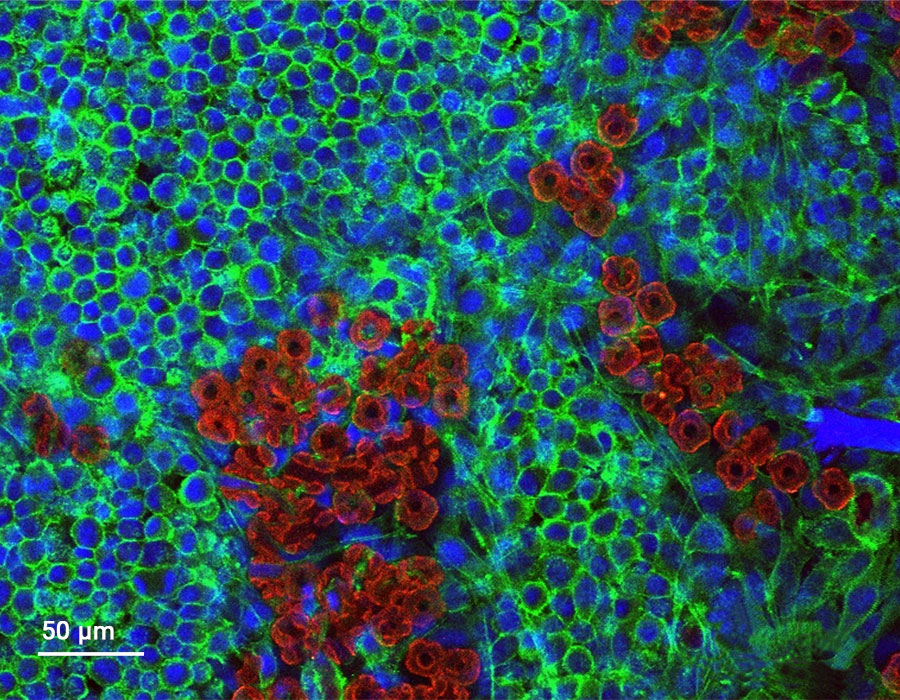A new microfabrication concept drives the scalable and continuous fabrication and assembly of particles in a flowing microfluidic system. Scientists in Aachen, Germany, develop and demonstrate a new in-flow, channel-integrated, continuous production process for ultra-small, arbitrarily shaped 3D particles. The process relies on Nanoscribe’s 2PP-based 3D printing technology. The printing process is showcased with the fabrication of 150,000 particles in 72 hours in one continuous run. The design freedom, shape accuracy, and materials flexibility of the 2PP process allow to fabricate particles with different shapes, in micrometer size, with submicron features and in various materials. The study aims to apply this particle assembly approach for tissue engineering applications. The investigation expands the scope for fabricating adaptive, responsive and permeable 3D scaffolds.
In-flow microfabrication and assembly of
any-shape particles for cell scaffolds
Millimeter- and micrometer-sized particles are useful and flexible building blocks for scaffolds that are needed in chemical and biochemical reactors. Bioreactors serve to immobilize and analyze enzymes, cells or microorganisms on the surface of the reactor’s internal structure. Key to the performance of bioreactors is the capability to tune the properties of the particles that affect the bioreaction characteristics.
With this application in mind, scientists from the RWTH Aachen University and the DWI - Leibniz Institute for Interactive Materials in Aachen, Germany, present a novel microfabrication concept called continuous two-photon vertical flow lithography. It allows high-throughput microfabrication of particles with complex shape, and micrometer size and submicrometer features in large quantities. The microparticles with a size around 20 µm make use of surface interactions for self-assembling 3D scaffolds. In their investigation, the 3D assemblies are analyzed with various particle shapes, sizes and materials regarding the assemblies' hydraulic resistance upon permeation and packing density.
In-flow printing of microparticles
But how does in-flow printing of microparticles work? The concept is based on the Two-Photon Polymerization (2PP) technology that happens within a microfluidic channel. The 2PP-laser is scanned in a single xy-plane while the liquid flow of the resin transports the printed xy-slice continuously in the z-direction. Once one particle is completed, the next one is printed the same way in a continuous printing process. Using Nanoscribe’s DeScribe software and adapting the output file with a phyton script, various designs with complex geometries can be sliced and prepared for in-flow printing. The in-flow production process is continuous and therefore allows to produce many thousands of particles in hours, up to 150,000 particles were printed in 72 hours. The particles can be produced in any shape, as 2PP-based in-flow printing benefits from the enormous design freedom that is characteristic of 2PP-based 3D printing.
In-flow printing of particles has advantages when compared to on-substrate printing because the continuous fabrication allows for printing one particle after the other, with no waiting time between two particles. The in-flow printing approach also circumvents the z-movement of the stage when printing layer by layer, because it is the flow that transports the xy-slice in the z-direction. Thus, in-flow printing represents a speed increase in the fabrication of small, complex-shaped particles.
Particles assemble towards 3D biohybrid tissue
Particles with sizes below 100 µm tend to self-assemble and build up complex scaffolds. The reacting characteristics of the scaffolds can be adjusted when tuning the particles shapes, size, porosity and material properties. This translates in a high flexibility when creating scaffolds for cell culture and tissue engineering. Tuning the particle geometry affects the surface-to-volume ratio, tailoring the hydrodynamics through and around the assembly. Nevertheless, there are still challenges to control the organization process of the particles when producing scaffolds by in-flow self-assembly.
Towards investigating 3D biohybrid tissue, the scientists studied cell culture of mouse fibroblasts cells in interaction with the in-flow printed particles. The particles were printed with Nanoscribe’s non-cytotoxic IP-Visio resin that features low fluorescence for better cell microscopy analysis. Four days of cultivation later, the cells interacted with the printed scaffolds, they proliferated, adhered to the scaffolds, infiltrated them, and interconnected the particles, building a new form of tissue.
Interested to explore more the novel in-flow printing and its applications for cell tissues? Read the open-access scientific publication here: Fabrication, Flow Assembly, and Permeation of Microscopic Any-Shape Particles
This and further scientific publications on more than a thousand research projects from Nanoscribe customers and system users can be found in a powerful database with a keyword search in the Premium Resources section. Register for free to see for yourself the potential of Nanoscribe’s 3D Microfabrication technology for innovative applications and fundamental innovations in many areas, and to evaluate its suitability for your project.
Video information
Video 1: Novel in-flow printing concept is used to fabricate microparticles within a microfluidic channel. The process relies on Nanoscribe’s 2PP-based 3D printing technology. Image: RWTH Aachen





